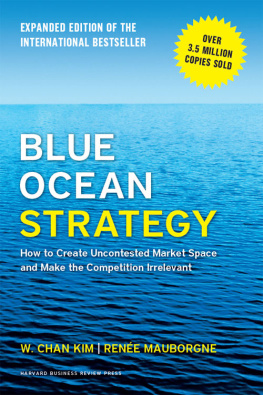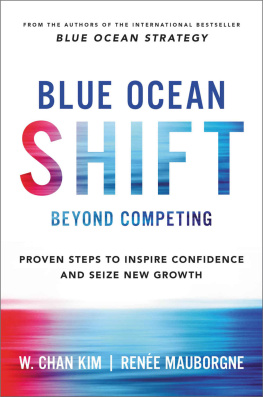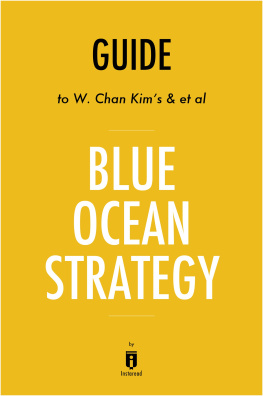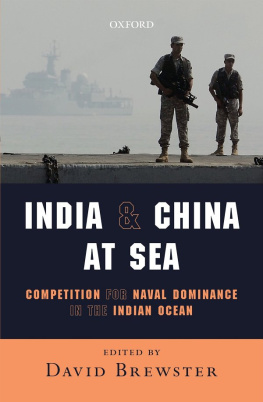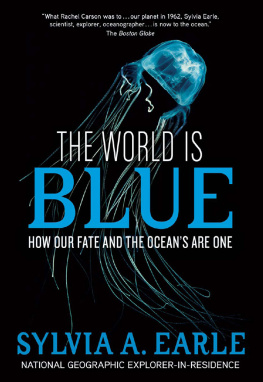No part of this publication may be reproduced, stored in or introduced into a retrieval system, or transmitted, in any form, or by any means (electronic, mechanical, photocopying, recording, or otherwise), without the prior permission of the publisher. Requests for permission should be directed to , or mailed to Permissions, Harvard Business School Publishing, 60 Harvard Way, Boston, Massachusetts 02163.
H ELP! MY OCEAN IS TURNING RED captures the sentiment echoed so frequently by managers around the world. More and more people, whether managers of companies, heads of nonprofits, or leaders of government, find themselves up against an ocean of bloody competition and want to get out. Maybe your business is seeing its margins shrink. Maybe competition is getting more intense, driving commoditization of your offering and rising costs. Maybe you know you are going to announce that salary increases wont be coming. Thats not a situation any one of us wants to face. And yet thats a situation that so many do face.
How can you address this challenge? The lessons, tools, and frameworks of Blue Ocean Strategy will help you to meet this challenge, whatever industry or economic sector you are in. It shows how you can get out of a red ocean of bloody competition and into a blue ocean of uncontested market space characterized by new demand and strong profitable growth.
When we wrote Blue Ocean Strategy , we used the metaphor of red and blue oceans because red oceans seemed to capture the reality that organizations increasingly face, while blue oceans captured the endless possibility that organizations could create, as industry history has borne out since its inception. Today, ten years later, more than 3.5 million copies of the book have been sold. It has become a bestseller across five continents. It has been translated into a record-breaking forty-three languages. And the term blue ocean has entered the business vernacular. Over four thousand articles and blog posts on blue ocean strategy have come out, with new articles continuing to appear daily worldwide.
The stories they contain are fascinating. There are articles from small business owners and individuals across the globe that discuss how the book fundamentally changed their perspectives on life and took their professional successes to all new levels. In other articles, executives speak of how blue ocean strategy provided the insight to take their business out of the red ocean and create all new demand. And yet other articles detail how government leaders have applied blue ocean strategy to achieve high impact at low cost with rapid execution in areas of social importance ranging from enhancing the quality of rural and urban lives, to strengthening internal and external securities, to breaking down ministerial and regional silos.
As we have reached out to organizations that have applied the ideas and have worked with many directly since the publication of the original edition of Blue Ocean Strategy , we have learned a lot by watching the journey people have made with these ideas. Their most pressing questions in executing their blue ocean strategies are: How do we align all of our activities around our blue ocean strategy? What do we do when our blue ocean has become red? How can we avoid the strong gravitational pulls of red ocean thinkingwe call them red ocean trapseven as were pursuing a blue ocean strategy? These are the very questions that have motivated this expanded edition. In this new preface, we first outline whats new here. We then briefly summarize the key points that define and distinguish blue ocean strategy and address why we believe blue ocean strategy is more needed and relevant than ever before.
Whats New in This Expanded Edition?
This edition adds two new chapters and expands a third. Here are the highlights that show the gist of managers key challenges and trouble spots and how we address them.
Alignment: What it means, why its essential, and how to achieve it. A challenge we have been told about and have seen organizations struggle with is how they can align their system of activitiesincluding a potential web of external partnersto create a sustainable blue ocean strategy in practice. Is there a simple yet comprehensive method to ensure that the key components of an organization, from value to profit to people, are aligned to support the strategic shift blue ocean strategy requires? This is important as companies all too often focus on certain dimensions of their organizations, paying less heed to other dimensions that must support the strategy to make it a sustainable success. In recognition, this expanded edition expressly explores the issue of alignment in the context of blue oceans. We present cases of success and failure in alignment to show not only how it is achieved in action but also how it can be missed. addresses this alignment challenge.
Renewal: When and how to renew blue oceans over time. All companies rise and fall based on the strategic moves they make or dont make. A challenge organizations face is how to renew blue oceans over time, as every blue ocean will eventually be imitated and turn red. Understanding the process of renewal is key to ensure that the creation of blue oceans is not a one-off occurrence but can be institutionalized as a repeatable process in an organization. In this expanded edition, we tackle how leaders can turn the creation of blue oceans from a static achievement into a dynamic renewal process both at the business level and at the corporate level for multibusiness firms. Here we articulate the dynamic renewal process for creating sustainable economic performance both for a single business that has reached for a blue ocean and for a multibusiness organization that has to balance both red and blue ocean initiatives. In so doing, we also highlight the complementary roles that red and blue ocean strategies play in managing a companys profit for today while building strong growth and brand value for tomorrow. addresses this renewal challenge.
Red Ocean Traps: What they are and why they should be avoided. Lastly, we show the ten most-common red ocean traps we see companies fall into as they put blue ocean strategy into practice. These traps keep companies anchored in the red even as they attempt to set sail for the blue. Addressing these traps is critical to getting peoples framing right to create blue oceans. With the proper grasp of the concept, one can avoid the traps and apply its associated tools and methodologies with accuracy so that right strategic actions can be produced to sail toward clear blue waters. addresses the challenge of red ocean traps.
What Are the Main Points of Distinction?
The aim of blue ocean strategy was straightforward: to allow any organizationlarge or small, new or incumbentto step up to the challenge of creating blue oceans in an opportunity-maximizing, risk-minimizing way. The book challenges several long-held beliefs in the field of strategy. If we had to zoom in on five key points of distinction that make the book worthy of consideration, it would be these.

